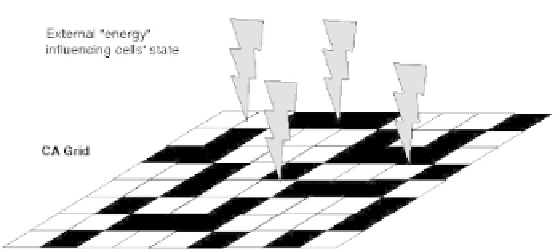Information Technology Reference
In-Depth Information
Fig. 3.
The basic structure of a dissipative cellular automaton: the environment influ-
ences the state of cells by injecting “energy”.
3 Emergent Behaviors
The behavior exhibited by DCA is dramatically different from both their syn-
chronous and closed asynchronous counterparts.
In general, when the degree of perturbation (determined by
λ
e
)is high enough
to effectively perturb the internal dynamic of the DCA (determined by the rate
of cell updates
λ
a
)but it is still not prevailing over it so as to make the behavior
of the DCA almost random (which happens when
λ
e
becomes comparable
λ
a
),
peculiar patterns emerge. Since the external perturbation strength is relative
to the cells update rate, i.e., the amount of perturbation is given by the ratio
between external and internal update rate, the actual control parameter is the
ratio
λ
e
/λ
a
.
We have observed that the perturbation on the cells induced by the external
- while keeping the system out of equilibrium and making impossible for it to
reach any equilibrium situation - makes DCA develop large-scale regular spatial
structures. Such structures show long-range correlation between the state of the
cells, emerged despite the strictly local and asynchronous transition rules, and
break the spatial symmetry of the final state. In addition, such structures are
stable, despite the continuous perturbing effects of the external environment.
Our experiments involved many combinations of rules for cells to live/die
and get alive and number of neighbors. We tested most of the rules which gen-
erate local patterns, excluding those leading to trivial attractors (i.e., all cells
alive/dead). For each combination of rules and neighborhood structures we sim-
ulated the CA dynamics starting from 20 different random initial states. The
interested reader can refer to the Web page: http://polaris.ing.unimo.it/DCA/
to access our simulation files in the form of applets, and appreciate the dynamic
evolution of these DCA by reproducing our experiments. In the following we will
discuss and show some among the typical results of the general phenomenon we
observed.

